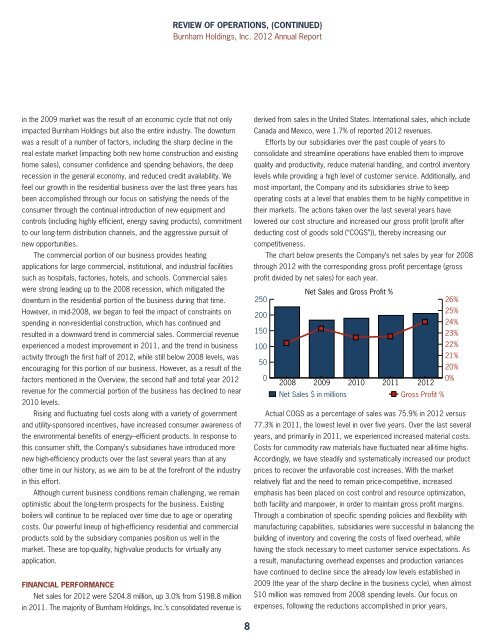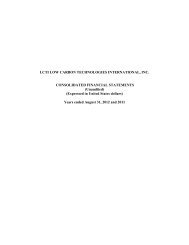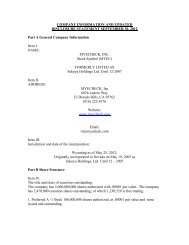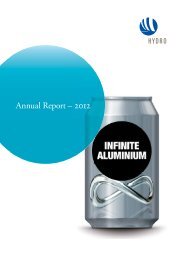Burnham Holdings, Inc.
Burnham Holdings, Inc.
Burnham Holdings, Inc.
You also want an ePaper? Increase the reach of your titles
YUMPU automatically turns print PDFs into web optimized ePapers that Google loves.
in the 2009 market was the result of an economic cycle that not only<br />
impacted <strong>Burnham</strong> <strong>Holdings</strong> but also the entire industry. The downturn<br />
was a result of a number of factors, including the sharp decline in the<br />
real estate market (impacting both new home construction and existing<br />
home sales), consumer confidence and spending behaviors, the deep<br />
recession in the general economy, and reduced credit availability. We<br />
feel our growth in the residential business over the last three years has<br />
been accomplished through our focus on satisfying the needs of the<br />
consumer through the continual introduction of new equipment and<br />
controls (including highly efficient, energy saving products), commitment<br />
to our long-term distribution channels, and the aggressive pursuit of<br />
new opportunities.<br />
The commercial portion of our business provides heating<br />
applications for large commercial, institutional, and industrial facilities<br />
such as hospitals, factories, hotels, and schools. Commercial sales<br />
were strong leading up to the 2008 recession, which mitigated the<br />
downturn in the residential portion of the business during that time.<br />
However, in mid-2008, we began to feel the impact of constraints on<br />
spending in non-residential construction, which has continued and<br />
resulted in a downward trend in commercial sales. Commercial revenue<br />
experienced a modest improvement in 2011, and the trend in business<br />
activity through the first half of 2012, while still below 2008 levels, was<br />
encouraging for this portion of our business. However, as a result of the<br />
factors mentioned in the Overview, the second half and total year 2012<br />
revenue for the commercial portion of the business has declined to near<br />
2010 levels.<br />
Rising and fluctuating fuel costs along with a variety of government<br />
and utility-sponsored incentives, have increased consumer awareness of<br />
the environmental benefits of energy–efficient products. In response to<br />
this consumer shift, the Company’s subsidiaries have introduced more<br />
new high-efficiency products over the last several years than at any<br />
other time in our history, as we aim to be at the forefront of the industry<br />
in this effort.<br />
Although current business conditions remain challenging, we remain<br />
optimistic about the long-term prospects for the business. Existing<br />
boilers will continue to be replaced over time due to age or operating<br />
costs. Our powerful lineup of high-efficiency residential and commercial<br />
products sold by the subsidiary companies position us well in the<br />
market. These are top-quality, high-value products for virtually any<br />
application.<br />
FINANCIAL PERFORMANCE<br />
Net sales for 2012 were $204.8 million, up 3.0% from $198.8 million<br />
in 2011. The majority of <strong>Burnham</strong> <strong>Holdings</strong>, <strong>Inc</strong>.’s consolidated revenue is<br />
REVIEW OF OPERATIONS, (CONTINUED)<br />
<strong>Burnham</strong> <strong>Holdings</strong>, <strong>Inc</strong>. 2012 Annual Report<br />
8<br />
derived from sales in the United States. International sales, which include<br />
Canada and Mexico, were 1.7% of reported 2012 revenues.<br />
Efforts by our subsidiaries over the past couple of years to<br />
consolidate and streamline operations have enabled them to improve<br />
quality and productivity, reduce material handling, and control inventory<br />
levels while providing a high level of customer service. Additionally, and<br />
most important, the Company and its subsidiaries strive to keep<br />
operating costs at a level that enables them to be highly competitive in<br />
their markets. The actions taken over the last several years have<br />
lowered our cost structure and increased our gross profit (profit after<br />
deducting cost of goods sold (“COGS”)), thereby increasing our<br />
competitiveness.<br />
The chart below presents the Company’s net sales by year for 2008<br />
through 2012 with the corresponding gross profit percentage (gross<br />
profit divided by net sales) for each year.<br />
250<br />
200<br />
150<br />
100<br />
50<br />
0<br />
Net Sales and Gross Profit %<br />
2008 2009 2010 2011 2012<br />
26%<br />
25%<br />
24%<br />
23%<br />
22%<br />
21%<br />
20%<br />
0%<br />
Net Sales $ in millions Gross Profit %<br />
Actual COGS as a percentage of sales was 75.9% in 2012 versus<br />
77.3% in 2011, the lowest level in over five years. Over the last several<br />
years, and primarily in 2011, we experienced increased material costs.<br />
Costs for commodity raw materials have fluctuated near all-time highs.<br />
Accordingly, we have steadily and systematically increased our product<br />
prices to recover the unfavorable cost increases. With the market<br />
relatively flat and the need to remain price-competitive, increased<br />
emphasis has been placed on cost control and resource optimization,<br />
both facility and manpower, in order to maintain gross profit margins.<br />
Through a combination of specific spending policies and flexibility with<br />
manufacturing capabilities, subsidiaries were successful in balancing the<br />
building of inventory and covering the costs of fixed overhead, while<br />
having the stock necessary to meet customer service expectations. As<br />
a result, manufacturing overhead expenses and production variances<br />
have continued to decline since the already low levels established in<br />
2009 (the year of the sharp decline in the business cycle), when almost<br />
$10 million was removed from 2008 spending levels. Our focus on<br />
expenses, following the reductions accomplished in prior years,









